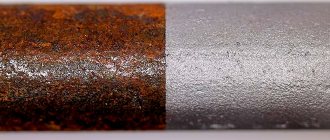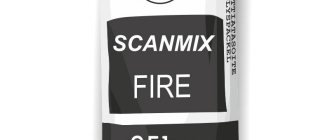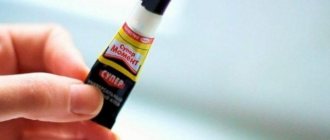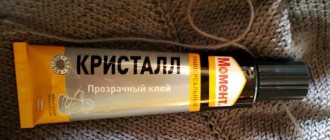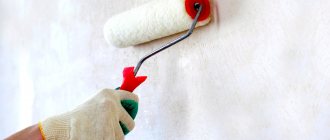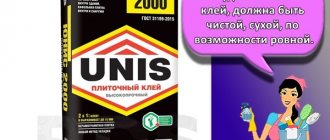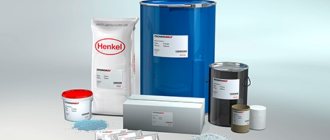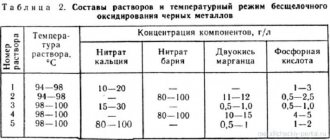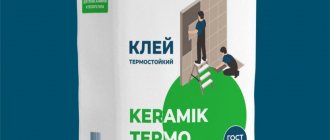Traces of glue from stickers are found in the most unexpected places: on the refrigerator door, on the sink, on the surface of the iron and more.
Dealing with the problem is not as easy as it might seem at first glance, because the sticky layer is very strong. Therefore, it will not be possible to get by with just plain water.
For information on how to remove sticker adhesive from metal, read the article.
Necessary Preface
There are several conditions that, if met, will allow you to quickly and effectively remove glue stains.
- Don't delay cleaning. If you remove a sticker that leaves a sticky mark, remove it immediately. Otherwise, the remaining glue will attract dirt, dust, and hairs, and if the sticker was on an enamel pan, then after the first use the fire will “impress” the dirt into the base, and it will be much more difficult to wash the sticker off such dishes.
- Meanwhile, moderate heat is a good assistant in cleaning. You can use a hair dryer. The softened adhesive trace can be easily wiped off with a napkin.
- When choosing a chemical, first check its effect on an inconspicuous area, and only then treat the entire desired surface.
What not to do
When cleaning various surfaces from glue, you must not:
- use abrasives and hard brushes to clean the glass surface, heat the remaining glue with a hairdryer - hot air may cause dark spots to appear on the mirror;
- remove dirt using metal objects - they scratch the surface;
- use a melamine sponge to clean dishes - melamine contains toxic substances.
Do not use aggressive chemicals or strong solvents to avoid damaging the surface and harming your health. It is better to use safer methods.
Available means
It is not economical to purchase expensive special products, because you don’t often have to deal with difficult-to-remove sticker stains. Try to make do with the funds that are always at hand.
Mechanical cleaning
If the stain is fresh, rub it off with your hands. The adhesive layer rolls off, shake it off. After this, wash off the residue with soapy water.
Melamine sponge
We enhance the effect with a melamine eraser sponge. The accessory is used to clean surfaces from stains of various origins. It will help in our case too.
We wet the contaminated area with water and apply the sponge to the stain until it disappears completely.
Eraser
We remove minor adhesive contamination with a school eraser.
- Moisten the desired area with water.
- We remove what we can with a coarse cloth.
- Leave to dry for a few minutes.
- Remove dirt with an eraser.
You may need to repeat the procedure.
Vegetable oil
A very effective remedy. You need flaxseed, olive or peeled sunflower. Apply the oil to the adhesive mark or difficult to remove sticker. After 2-3 minutes, when the paper and glue are saturated, remove them using a fingernail, knife or an unnecessary plastic card. Then we rinse this area with hot water.
Mayonnaise
In this product, vegetable oil takes up up to 70 percent. So mayonnaise is quite suitable for removing glue. We proceed in a similar way.
Liquids containing alcohol
You can use any alcohol, deodorant, cologne. The higher the percentage of alcohol in the liquid, the more effective the cleaning will be. We proceed like this:
- soak a napkin in alcohol and wring it out;
- wipe off the remaining sticker;
- wash it off.
We act carefully, having first checked whether the alcohol will harm the surface being treated.
Scotch
Sometimes the method known as “knocking out a wedge with a wedge” helps. It will work if the sticker stain is fresh. We glue a piece of tape onto it, and then quickly tear it off. Together with the adhesive tape, the remaining remaining sticker and glue from it will be removed. We do this several times.
Vinegar
You will need table vinegar, not essence. The liquid is not aggressive, so we use it on any surface. Vinegar will remove even old, dried traces of glue.
After applying the substance to the contaminated area, wait 5 minutes, allowing the paper and glue to soften, and then remove the softened mass with a non-sharp knife. To completely remove the stain, wipe with a sponge dipped in soapy water.
Petrol
Refined gasoline, kerosene, and lighter fluid can also easily remove adhesive films.
- We saturate the napkin with the flammable mixture.
- We wipe away the glue trace.
- After 2-3 minutes, apply the same cloth to the stain again until it disappears.
- Wash with soapy water.
Attention
Do not use flammable mixtures on lightweight plastic. If you are deciding how to remove stickers from furniture painted with alkyd paint, be careful too. Gasoline and similar liquids have solvent properties.
Household hair dryer
We use it to remove adhesive traces from different surfaces - both metal and fabric.
- Warm up the stain with a hairdryer.
- Remove the softened mass.
- Apply a thin layer of sunflower oil.
- After 5-7 minutes, wipe with a napkin.
- Wash off with soapy water.
It is better not to use a powerful hair dryer or turn it on at minimum heat.
Acetone
We use the substance in conjunction with a hair dryer. First, heat the adhesive label with a hairdryer, remove the softened substance with a thin object, and then wipe off the remaining sticky trace with a napkin soaked in acetone. The solvent can be replaced with nail polish remover.
Wet wipes
This method will help with minor contamination. You can rub a stubborn stain until it disappears, but you will have to spend a lot of time and effort.
Dish gel
Use to remove glue on fabric.
- Wet the contaminated area with water and apply the gel.
- After 2-3 minutes, wipe with a napkin.
- We wash the item completely; if it is furniture upholstery, we wipe it with a damp cloth.
Steam
Thermal exposure is suitable for materials that are not afraid of high temperatures.
- Heat the kettle on the stove until it boils.
- We bring the surface that needs cleaning to the steam spout.
- After a couple of minutes, remove the sticker fragments along with the glue.
- Wash the affected area with soapy water.
Lemon
The acid contained in the fruit will soften the glue.
- Wipe the stain with a piece of lemon and wait 2-3 minutes.
- Scrape off the softened mass.
- Wash off the residue with hot water.
We can achieve the desired effect with a solution of citric acid powder. We soak a napkin in it and wipe off the dirt.
Important
When choosing how to remove a sticker, we take into account the material with which you will have to work and the specifics of the objects themselves. Before washing off stains, disconnect electrical appliances from the network. We do not abuse liquids.
Removing sticky marks with steam
One of the simplest ways to remove a sticky sticker. Hot damp air softens the glue, becomes more sticky, and is easier to remove. If you have a clothes steamer or an iron with this function, you can use them. If not, there is an old reliable method - a steam bath.
- Pour water into a saucepan or metal container. Bring to a boil, hold the area to be cleaned over water vapor.
- Try removing any remaining glue with a wooden stick, your hands, or a rag (depending on the degree of contamination).
- If necessary, hold the item over the steam again.
How to remove stickers from furniture
It's not just price tags that have to be removed from furniture. Children often place colorful stickers, which over time deteriorate, fade and spoil the impression of the room. After removing the top paper part, the bottom layer remains on the glue. You need to get rid of it immediately, because very soon it will become covered in dust. What to do?
Hairdryer
Using a heated device, soften the glue and, prying it with a sharp object, remove it entirely from the surface. You should not heat the dryer too much if you are working with polishing or varnishing. After the procedure, wash the surface with soapy water and wipe dry.
Scotch
We take not ordinary, but construction tape, the adhesive base of which holds firmly and can attract other substances. We paste two layers of tape on the mark of the sticker, larger in size than the sticker was. We tear it off sharply. Ideally, the tape will tightly attract adhesive contamination.
Vegetable oil
Suitable for varnished surfaces, from which it will carefully remove stains. All that remains is to wash the treated area with soapy water. You may have to repeat the procedure twice. Do not use on natural wood!
Nail polish remover
The impact on the varnished surface should be short-lived. We soak a napkin with liquid and press it onto the remaining sticker. We wipe the stain almost immediately. It must disappear. We wash off traces of the product, wait for the surface to dry, and rub it until it shines.
Special product for removing stickers
Usually it's a spray. The product is sprayed onto the stain and after a short time the sticker is washed off along with the base. The surface will not be damaged.
Mechanical method
Suitable for easy to remove labels. Even if the label was removed without problems, it still leaves a small trace of adhesive. Remaining adhesive can be removed mechanically. You need to rub the remaining glue in one direction, gradually rolling it into a ball. It is not recommended to remove the label with your nails, as they can easily be broken. It is better to use a spatula or pocket knife.
Remaining glue cannot be washed in different directions, as the glue will be smeared on the surface.
How to remove stickers from dishes
Sellers generously supply cutlery, plates, glasses made of porcelain, glass ceramics, and ceramics with stickers. What are we doing?
- Heat with a hairdryer or boiling water, then wash with a hard sponge.
- We saturate the sticker with oil and remove it with a non-sharp object.
- Take dishwashing gel, add citric acid to it, and use the resulting product to wipe off the adhesive stain.
- Prepare a concentrated solution of citric acid and water, moisten a napkin and wipe off the dirt.
- Use acetone (or acetone-based nail polish remover).
It is better to combine scrubbing with washing dishes in hot water.
Thus, it is not difficult to get rid of the remaining adhesive base of the sticker. Assess the risks when choosing a product and act.
Vegetable oil
To remove the glue, you need to treat the contaminated area with vegetable oil. Then leave the item for 10 minutes so that the oil saturates the contaminated surface. After this, the glue will soften and can be scraped off using an unnecessary plastic card. If this is not available, you can use a metal ruler or a pocket knife.
After removing the contamination, the remaining oil must be washed off using dishwashing detergent or laundry soap.
Vegetable oil can be replaced with other fat-containing products, such as mayonnaise.
Precautionary measures
If you decide to go on the attack, armed with industrial solvents or machine fuel, then follow these precautions:
- wear rubber gloves;
- work only in a well-ventilated area, as their vapors are toxic;
- be sure to check the reaction of the product material in an inconspicuous area;
- if the item is small in size and you will be processing it above a table or in another place, lay down oilcloth or newspapers to protect the work surface;
- When choosing a special sticker remover, read the instructions carefully before use and use this spray or liquid only for the surfaces specified in it.
Stickers on cars and household appliances
Removing a label from a car is quite simple; for this you will need:
- household hair dryer;
- car cleaner;
- construction hairdryer (installed at gas stations and service stations).
When exposed to hot air, the paper peels off easily, and its sticky layer is removed with a plastic scraper . Do not use a metal sponge - it will scratch the car's paint.
Under the influence of hot air, the paper peels off easily, and its sticky layer is removed with a plastic scraper
To clean equipment use:
- oil: corn, olive, sunflower;
- cleaners;
- hairdryer
Essential oils
Sometimes essential oils help get rid of glue stains. But they are not suitable for all types of plastic. Before removing stains with essential oil, check its compatibility with the selected surface by dropping a small amount of the substance in an inconspicuous place.
If a stain appears that cannot be wiped off, you should choose a different cleaning method. If there are no traces, cleaning using the chosen method is quite possible. The surface should be cleaned in the same way as when cleaning with vegetable oil.

